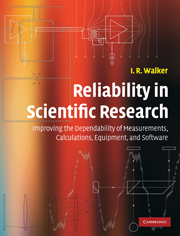 Reliability in Scientific Research
Reliability in Scientific Research Book contents
- Frontmatter
- Contents
- Preface
- List of abbreviations
- 1 Basic principles of reliability, human error, and other general issues
- 2 Mathematical calculations
- 3 Basic issues concerning hardware systems
- 4 Obtaining items from commercial sources
- 5 General points regarding the design and construction of apparatus
- 6 Vacuum-system leaks and related problems
- 7 Vacuum pumps and gauges, and other vacuum-system concerns
- 8 Mechanical devices and systems
- 9 Cryogenic systems
- 10 Visible and near-visible optics
- 11 Electronic systems
- 12 Interconnecting, wiring, and cabling for electronics
- 13 Computer hardware and software, and stored information
- 14 Experimental method
- Index
- References
10 - Visible and near-visible optics
Published online by Cambridge University Press: 05 June 2012
- Frontmatter
- Contents
- Preface
- List of abbreviations
- 1 Basic principles of reliability, human error, and other general issues
- 2 Mathematical calculations
- 3 Basic issues concerning hardware systems
- 4 Obtaining items from commercial sources
- 5 General points regarding the design and construction of apparatus
- 6 Vacuum-system leaks and related problems
- 7 Vacuum pumps and gauges, and other vacuum-system concerns
- 8 Mechanical devices and systems
- 9 Cryogenic systems
- 10 Visible and near-visible optics
- 11 Electronic systems
- 12 Interconnecting, wiring, and cabling for electronics
- 13 Computer hardware and software, and stored information
- 14 Experimental method
- Index
- References
Summary
Introduction
In certain types of optical measurements, such as those making use of interference, the most elusive sources of reliability difficulties are structural vibrations, acoustic disturbances, and temperature variations in the optical path. The first two phenomena are often a problem in many types of sensitive measurement in research, and these issues are discussed in detail in Section 3.5.3. Temperature effects are examined in the following section.
Precision positioning devices in optical systems can cause difficulties due to mechanical instabilities and other problems. These are discussed in Section 8.2.3.
The most general problem in optical work – affecting all apparatus to a greater or lesser degree – is contamination of optical surfaces. At one end of the scale, the problem may be merely scattering of light by dust (a serious issue in the case of, for example, diffraction gratings), which can often be solved by protecting and/or cleaning the surfaces using elementary methods. At the other extreme, when high-powered lasers are involved, contamination of optical surfaces may result in damage, or even destruction, of optical components. The process of cleaning optical surfaces may itself be difficult, depending on the character of the devices involved and the nature of the contaminants. If done frequently, cleaning can easily be more detrimental to the performance of the optics than the presence of contamination. These issues are discussed in more detail in Section 10.6.
- Type
- Chapter
- Information
- Reliability in Scientific ResearchImproving the Dependability of Measurements, Calculations, Equipment, and Software, pp. 310 - 352Publisher: Cambridge University PressPrint publication year: 2011


